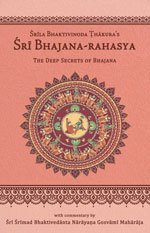Bhajana-Rahasya
by Srila Bhaktivinoda Thakura Mahasaya | 2010 | 123,965 words
The Bhajana-rahasya Text 16, English translation, including commentary (vritti). The Bhajana-rahasya is a compilation of verses describing the mercy of the eight pairs of names (Yugala-nama) of the Maha-mantra. This is text 16 belonging to the chapter “Saptama-yama-sadhana (Pradosha-kaliya-bhajana–vipralambha-prema)” representing from six dandas of the night until midnight: approximately 8.30 p.m.–00.00 a.m.
Text 16
Kṛṣṇa-karṇāmṛta (68) describes an internal vision (sphūrti-darśana ) of Śrī Kṛṣṇa:
मारः स्वयं नु मधुर-द्युति-मण्डलं नु माधुर्यम् एव नु मनो-नयनामृतं नु
वेणी-मृजो नु मम जीवित-वल्लभो नु कृष्णोऽयम् अभ्युदयते मम लोचनायmāraḥ svayaṃ nu madhura-dyuti-maṇḍalaṃ nu mādhuryam eva nu mano-nayanāmṛtaṃ nu
veṇī-mṛjo nu mama jīvita-vallabho nu kṛṣṇo[1]'yam abhyudayate mama locanāyaIs this Cupid himself, or is it a halo of sweet effulgence? Is this the personification of sweetness or the life-giving nectar of the mind and eyes? Is this the lover who loosens My braid, the beloved of My life, the youthful Kṛṣṇa, who has manifested before My eyes?
स्वयं कन्दर्प एकि, मधुर-मण्डल नाकि,
माधुर्य आपनि मूर्तिमान
मनो-नयनेर मधु, दूर ह’ते आइल बन्धु,
जीवन-वल्लभ व्रज-प्राणsvayaṃ kandarpa eki, madhura-maṇḍala nāki,
mādhurya āpani mūrtimāna
mano-nayanera madhu, dūra ha’te āila bandhu,
jīvana-vallabha vraja-prāṇaआमार नयन-आगे, आइल कृष्ण अनुरागे,
देहे मोर आइल जीवन
सब दुःख दूरे गेल, प्राण मोर जुडाइल,
देख सखि! पाइनु हाराधनāmāra nayana-āge, āila kṛṣṇa anurāge,
dehe mora āila jīvana
saba duḥkha dūre gela, prāṇa mora juḍāila,
dekha sakhi! pāinu hārādhana
Commentary: Bhajana-rahasya-vṛtti:
After Śrī Kṛṣṇa disappeared from the rāsa-līlā, the gopīs sang a piteous kīrtana filled with the mood of separation from Him. At that time, Kṛṣṇa, who is manmatha-manmatha, the bewilderer of the mind of Cupid, appeared before them. In Śrīmad-Bhāgavatam (10.32.2) Śrīla Śukadeva Gosvāmī describes that unprecedentedly beautiful form of Kṛṣṇa: “tāsām āvirabhūc chauriḥ smayamāna-mukhāmbujaḥ–with a smile on His lotus face, Kṛṣṇa came before the gopīs. Wearing a flower garland and a yellow garment, He appeared directly as one who can bewilder the mind of Cupid, who himself bewilders the minds of ordinary people.”
Śauri Śrī Kṛṣṇa, who defeats even Cupid, appears before the gopīs. Upon seeing His beauty, Rādhā becomes perplexed and wonders, “Is Kṛṣṇa really present before us?” Confused, She says to Her sakhīs, “O sakhīs, is He who is standing before us Cupid incarnate, whose invisible form attacks everyone?” Here in this Text, the word nu (meaning ‘whether’) is used in the sense of deliberating. Again perceiving His sweetness, She says with astonishment, “That Cupid cannot be so sweet, so is this a halo of sweet beauty? This is also astonishing. No, no it is not merely a halo of beauty, it is some kind of embodied sweetness. No other kind of sweetness can satisfy our eyes, but our eyes are satisfied with this darśana.” With great pleasure, She says, “Is this nectar itself? But sakhī, nectar does not have a form and this does, so it cannot be nectar.” Again She says, “Is it our beloved, who loosens our braids, who has come to us out of love?” Looking very carefully at Kṛṣṇa, She blissfully says, “O sakhīs, it is the love of our lives, the fresh, youthful dancer (nava-kiśora-naṭavara). It is He who gives pleasure to the eyes and who is our prāṇakānta.”
Footnotes and references:
[1]:
In some editions of Kṛṣṇa-karṇāmṛta ‘kṛṣṇo’ reads ‘bālo’.
